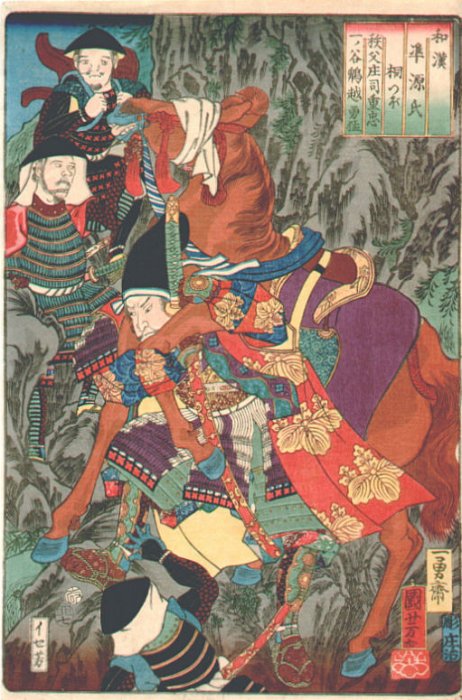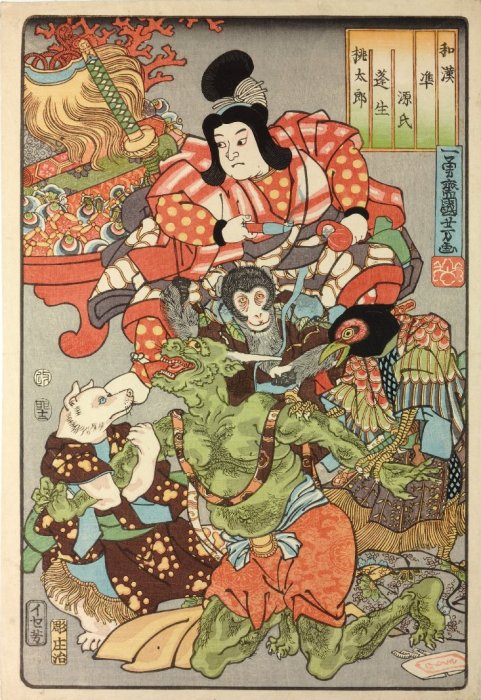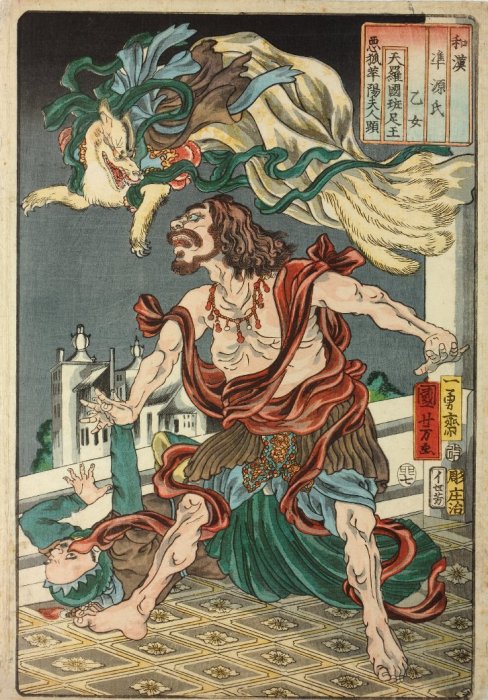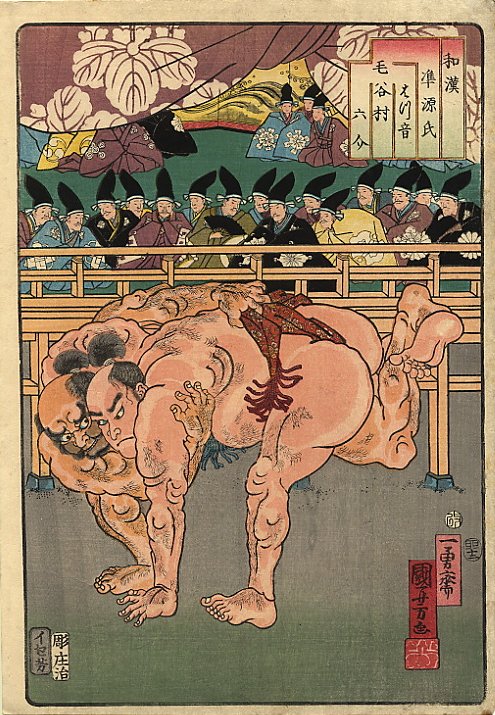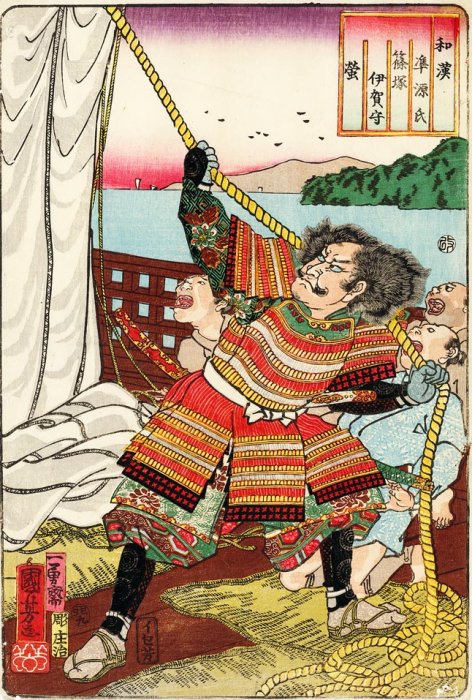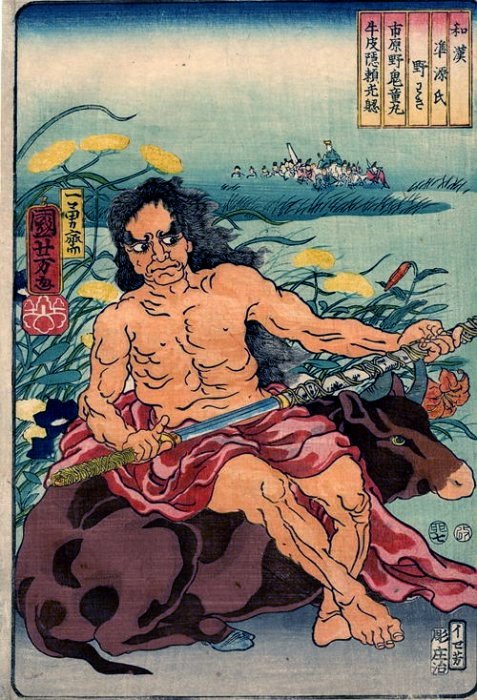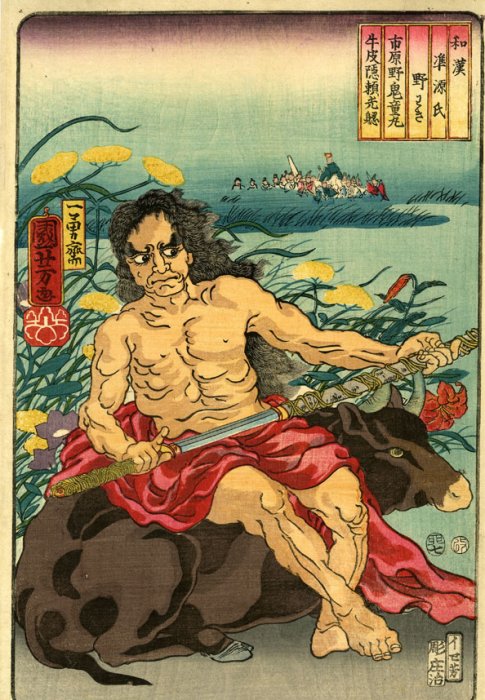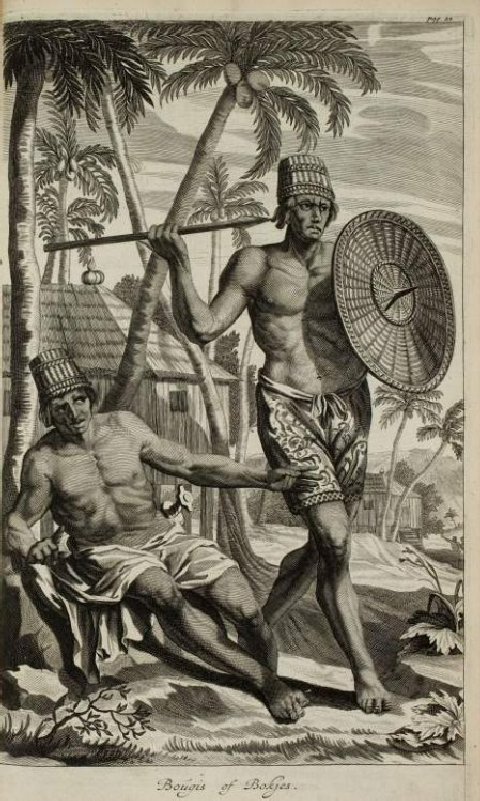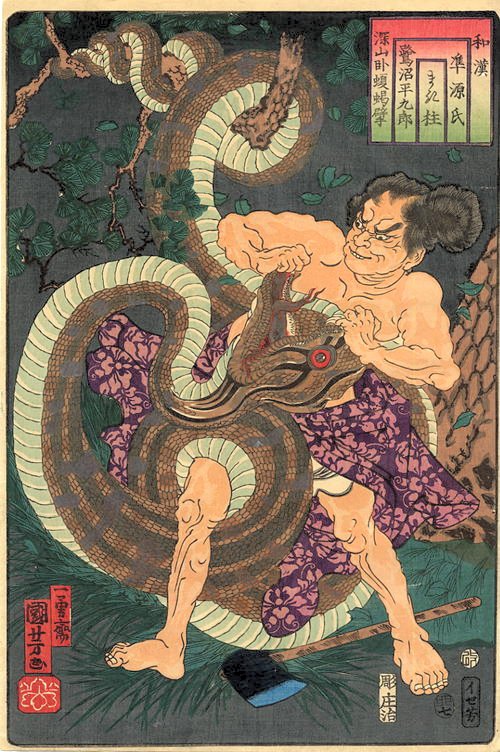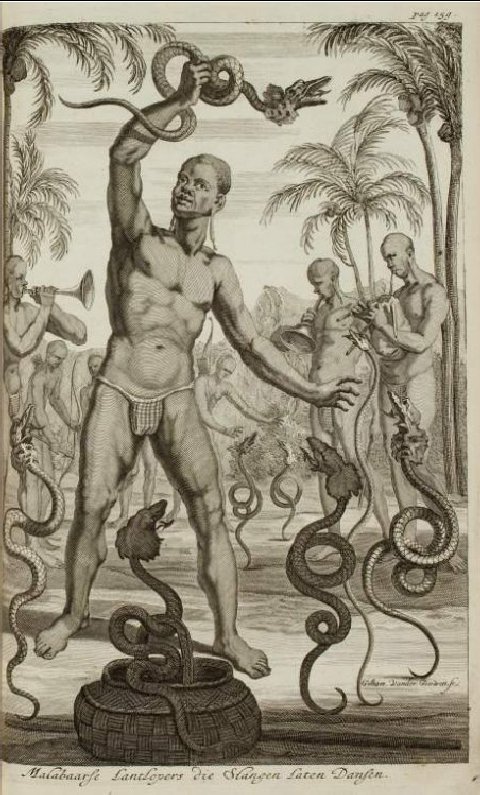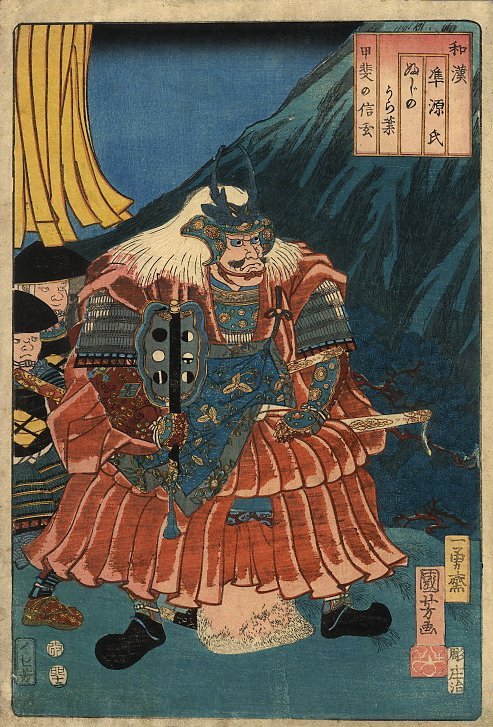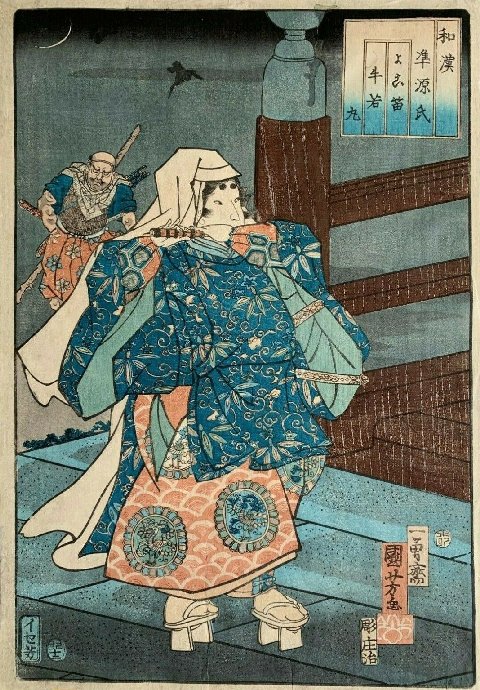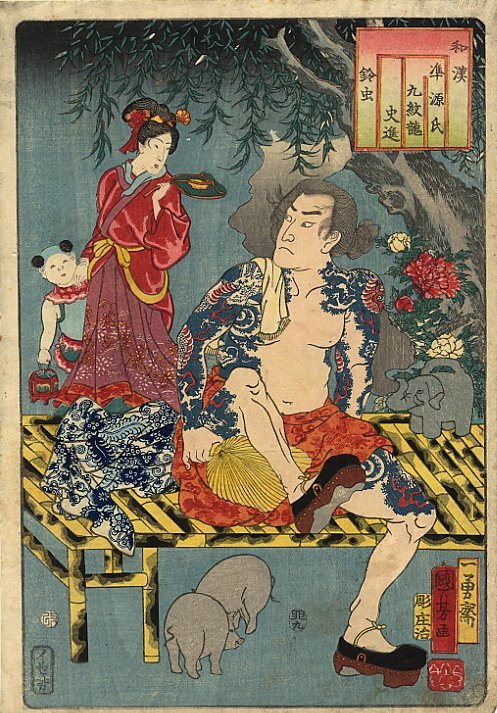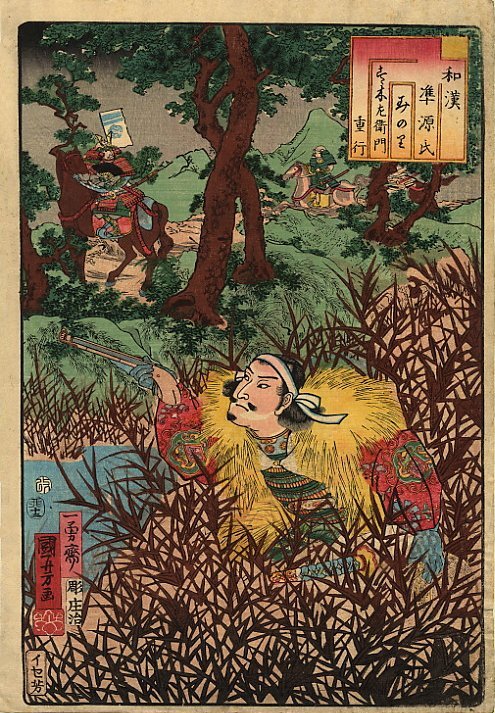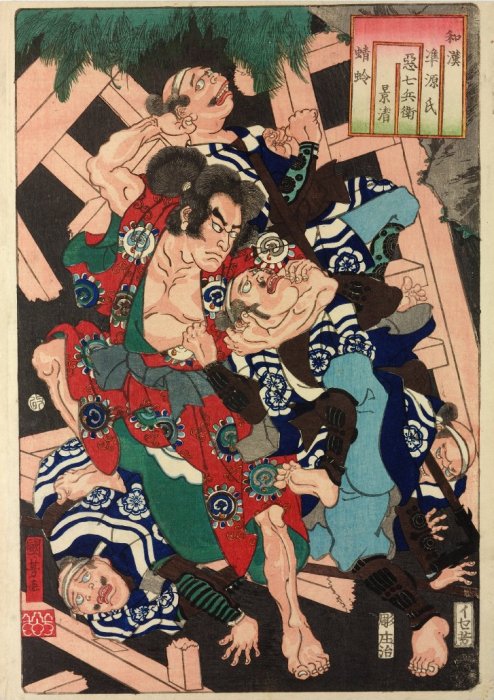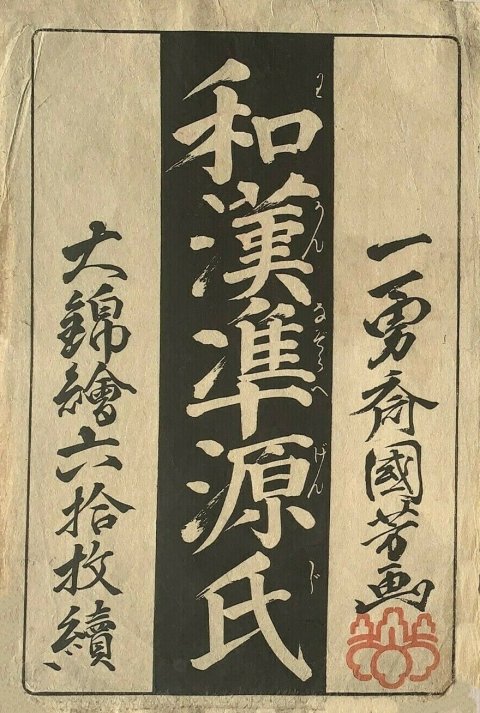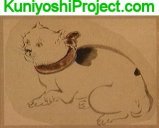Japanese and Chinese Comparisons for the Chapters of
Genji
(Wakan nazorae Genji, 和漢准源氏)
Publisher: Ise-Yoshi
1855-1856
|
The Tales of Genji (Genji monogatari) is the greatest novel in classical
Japanese literature, and arguably, the world’s first novel. It was written in the first decade of the
eleventh century by Lady Murasaki, and relates the womanizing exploits of
Prince Genji. Each of the fifty-four
chapters of the novel is named and is associated with a crest called a Genji-mon. Two different standard forms of the crests
are reproduced below, but they do not always correspond with the chapter
assigned to each print by Robinson. In
this series, Kuniyoshi paired scenes from history, fiction, and legend with
related chapters from the novel. The
total number of prints in this series is unknown, but all the prints known to
Robinson are listed and pictured below.
The prints are each about 14 by 10 inches (36 by 25 centimeters), a
size known as ôban. |
|
|
Chapter number: 1 Chapter name: Kiritsubo (桐壺, Paulownia
Court) Scene: Chichibu Shôji Shigetada (秩父荘司重忠) carrying his
blindfolded horse down the steep hill at Hiyodori-goe Robinson: S88.1 |
|
|
Another state of the above design |
|
|
Chapter number: 6 Chapter name: Suetsumuhana (末摘花, The Saffron
Flower) Scene: Mukwan no Tayû Atsumori (無官太夫 敦盛) riding out to
sea at Ichi-no-tani while Kumagae
Naozane (熊谷直實) hails him
from shore Robinson: S88.6 |
|
|
Chapter number: 8 Chapter name: Hana no En (花宴, Festival of
Cherry Blossoms) Scene: Shanaô (Buddhist name of Minamoto no Yoshitsune)
leaping among the pine trees of Kuramayama to the
astonishment of his tengu fencing
partners and their king who sits in the background Robinson: S88.8 NOTE: Tengu are forest-dwelling creatures
that are either human-like with wings and long noses or bird-like. |
|
|
Chapter number: 12 Chapter name: Suma (須磨, Suma) Scene: Kaidômaru (會童丸) up a tree
with the monkeys watched by his mother, Yama-uba (山姥), below Robinson: S88.12 I am grateful to Ward Pieters for locating this image. |
|
|
Chapter number: 13 Chapter name: Akashi (明石, Akashi) Scene: Baba Mino no
Kami (馬場美濃守) killing an
enemy with his sword, while storming forward on his horse Robinson: S88.13 |
|
|
Chapter number: 15 Chapter name: Yomogyû (蓬生, Wormwood
Patch) Scene: Momotarô (桃太郎, Little Peachling), a monkey, a badger a pheasant and captive
demon with “the five precious things” on stand behind them Robinson: S88.15 |
|
|
Chapter number: 16 Chapter name: Sekiya (関屋, The
Gatehouse) Scene: Guan Yu (関羽五関破) on horseback
destroying “The 5 Barriers” loping off heads with a pole arm left and right Robinson: S88.16 |
|
|
Chapter number: 17 Chapter name: E-awase (絵合, Picture
Contest) Scene: Iga Jutarô (伊賀寿 太郎), on foot,
seizes a mounted foe by the belt Robinson: S88.17 |
|
|
Chapter number: 19 Chapter name: Usugumo (薄雲, Wisps of
Cloud) Scene: Raikô (源頼光), who is ill,
drawing his sword as the Earth-Spider envelops him in its web Robinson: S88.19 |
|
|
Chapter number: 21 Chapter
name:
Otome (乙女, The Maiden) Scene: Prince Hansoku (帆足王) of India and
Lady Kayo flying away as she reveals her true identity as a nine-tailed fox Robinson: S88.21 |
|
|
Chapter number: 22 Chapter name: Tamakazura (玉っつら, Jewel
Garland) Scene: Takeshiuchi no Sukune (武内宿称) looking over
the side of his ship and being offered two magic jewels (senju and manju) by the Dragon King Robinson: S88.22 |
|
|
Chapter number: 23 Chapter name: Hatsune (初音, First
Warbler) Scene: Keyamura Rokusuke (毛谷村 六介) wrestling
before an audience of noblemen Robinson: S88.23 |
|
|
Chapter number: 25 Chapter name: Hotaru (螢, Fireflies) Scene: Shinozuka Iga no Kami (篠塚 伊賀守)
single-handedly hoisting a ship’s sail to the amazement of members of the
crew Robinson: S88.25 |
|
|
Chapter number: 27 Chapter name: Kagaribi (篝火, Flares) Scene: Yamatotakeru-no-mikoto (日本武 尊) using his
“grass-mowing sword” to foil an attempt to trap him in burning grass Robinson: S88.27 |
|
|
Chapter number: 28 Chapter name: Nowaki (野わき, Typhoon) Scene: Kidômaru (鬼童丸) seated on a
water buffalo draws his sword as Raikô and his followers approach over the Ichihara Moor Robinson: S88.28 |
|
|
Another state of the above design |
|
|
This print by Johan Nieuhof (1618-1672) may have
influenced the preceding print by Kuniyoshi.
Kuniyoshi is known to have had access to a book of Johan Nieuhof’s
engravings. |
|
|
Chapter number: 29 Chapter name: Miyuki (御幸, Royal Outing) Scene: Hyôshitô Rinchû (豹子頭林沖) emerging from
a temple with spear in hand watching three straw-cloaked men in
discussion. This is a scene from the
semi-historical Chinese novel, Suikoden. Robinson: S88.29 |
|
|
Chapter number: 30 Chapter name: Fujibakama (藤袴, Purple
Trousers) Scene: Watônai (和藤内), who is also
known as Katô Kiyomasa, on the Korean shore with
two retainers Robinson: S88.30 |
|
|
Chapter number: 31 Chapter
name:
Maki-bashira (まき柱, Cypress
Pillar) Scene: Sagi-no-ike Heikurô (鷺池平九郎) wrestling
with a giant python in the mountains Robinson: S88.31 |
|
|
This print by Johan Nieuhof
(1618-1672) may have influenced the preceding print by Kuniyoshi. Kuniyoshi is known to have had access to a
book of Johan Nieuhof’s engravings. |
|
|
Chapter number: 33 Chapter name: Fuji no uraba
(梅枝, Wisteria
Leaves) Scene: Takeda
Shingen of Kai (甲斐の信玄) armed and
seated at the foot of Mount Asama Robinson: S88.33 |
|
|
Chapter number: 34 Chapter name: Wakana no jô
(若菜上, New Herbs,
Part I) Scene: Abe no Sadatô (安倍 貞任) being pursued
by Hachiman-tarô Yoshi-ie
(八幡太郎義家), both on horseback Robinson: S88.34 |
|
|
Chapter number: 37 Chapter name: Yokobue (よこ笛, The Flute) Scene: Ushiwakamaru (牛若丸) playing his
flute on Gojô Bridge with Benkei lurking in the
background Robinson: S88.37 |
|
|
Chapter number: 38 Chapter name: Suzumushi (鈴虫, Bell Cricket) Scene: The great
wrestler Kyumonryô Shishin
(九紋龍 史進) seated on a
bamboo bench beneath which are two piglets with a woman and child
behind. This is a scene from the
semi-historical Chinese novel, Suikoden. Robinson: S88.38 |
|
|
Chapter number: 40 Chapter name: Minori (みの里, The Rights) Scene: Suzuki Saemon Shigeyuki (すづ小左衛門重行) lying in
ambush and aiming his pistol at Nobunaga
Robinson: S88.40 |
|
|
Chapter number: 42 Chapter name: Niônomiya (匂宮, His Perfumed
Highness) Scene: Mega Magosaburô (妻鹿 孫三郎) at the Battle
of Miidera defending the gateway amid a hail of
arrows Robinson: S88.42 |
|
|
Chapter number: 48 Chapter name: Sawarabi (早蕨, Early Ferns) Scene: Gyôja Bushô (行者武松). A hero of
the semi-historical Chinese novel, Suikoden, overcoming a tiger with his bare
hands Robinson: S88.48 |
|
|
Chapter number: 51 Chapter name: Ukifune (浮舟, Boat on the
Water) Scene: Nogi Nyûdô Raigen (野木入道来玄) using a
wooden shield (tate)
as a raft and paddling with a naginata
amid a flight of arrows Robinson: S88.51 |
|
|
Chapter number: 52 Chapter name: Kagerô (蜻蛉, Boat on the
Water) Scene: Akushichibyôe Kagekiyo (惡七兵衛景清) struggling with
several men who are trying to arrest him in front of a broken wooden grating Robinson: S88.52 |
|
|
Cover sheet for this series |
|
“Robinson” refers to listing in Kuniyoshi: The Warrior-Prints by Basil William Robinson (Cornell University Press, Ithaca, NY, 1982) and its privately published supplement. CLICK HERE TO RETURN TO MAIN
PAGE
|


